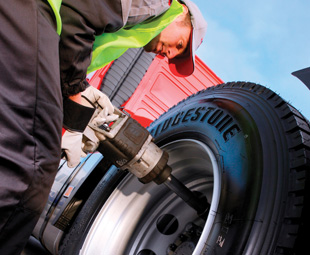Costly rolling

Neglecting the cost of the tyres in their fleets is one of the biggest, most expensive mistakes operators make. VIC OLIVER presents some dos and don’ts to make the task a little easier
The cost of tyres is a major component of operating costs in a heavy-duty truck or bus fleet and it is amazing how often the management of this important function is neglected. In many transport companies there is an opportunity to reduce costs and increase profits by improving vehicle tyre management.
In order to establish how much tyres cost in a long-distance operation, I enlisted the help of Martin Dammann from Hellberg Transport Management (HTM), a well-respected company in the trucking industry that specialises in accurately forecasting vehicle operating costs.
Using a long-distance operation covering 900 000 km over a five-year period for a truck tractor and a set of interlink trailers, and estimating the lifespan of each tyre at 100 000 km, the HTM simulated operating cost program recorded the total costs of tyres at R925 560 – or 6,7 percent of the variable vehicle operating costs.
In fleets where there is no focus on tyre management, this cost would be much greater and would come directly out of the operator’s profit margin.
Many operators outsource the management and control of the tyres in their fleet to professional tyre management companies. This concept is fine and works well, provided the vehicle operator and his drivers understand that they still have a role to play in ensuring that tyres in the fleet are properly managed.
They must also view the people, who are placed in their business by the service provider, as part of their team and work together with them in the management of this important function.
While there are many aspects to managing the tyres in a fleet, one of the best ways is to install a system that accurately accounts for all the related tyre costs, which can then be tabulated to provide a true cost per kilometre (CPK) for each and every tyre in the fleet.
The total CPK is not the cost of the actual tyre, but how many kilometres it has covered from the time of its purchase to the time that it is removed and scrapped. Accurate tyre CPK information can be used to effectively manage tyres and will give an operator the means to select the correct tyre for the particular operation.
It will measure performance against other depots in the group and against industry standards. It will also highlight problem areas, such as driver abuse and vehicle and trailer issues, and assist operators to take immediate action to rectify any problem that is contributing to excess tyre costs on a vehicle.
One of the basic functions of good vehicle tyre management is to ensure that the tyre pressures are always correct and that all the tyres are fitted with valve caps and, on dual wheels, with valve extensions.
Often drivers feel that this function is not their responsibility, because it is not part of their job description. They assume that it is someone else’s job; either the person employed by the outsourced tyre management company or their own workshop personnel.
Experience has shown that if we leave the care of the tyres to these people, and the driver is not involved as part of the team to ensure that the tyres are correctly inflated at all times, tyre costs will rise.
The following table is published by a tyre manufacturer and illustrates the loss in original kilometres when tyres are under inflated (with 100 000 km taken as normal tyre life expectancy).
10 percent under inflation = five percent or 5 000 km lost
20 percent under inflation = 16 percent or 16 000 km lost
30 percent under inflation = 33 percent or 33 000 km lost
40 percent under inflation = 45 percent or 45 000 km lost
50 percent under inflation = 60 percent or 60 000 km lost
There are many other reasons that cause tyre costs to rise, such as bad wheel alignment, harsh braking, poor route conditions, incorrect fifth wheel position and incorrect mass distribution – to name just a few.
The only way to professionally manage this important function and improve your profit margin is to have a proper system in place that records all tyre costs for each and every tyre in your fleet, and transforms the information into a CPK figure.
The (recycled) wheels are turning
 This year has seen its highs and lows – much like the Recycling and Economic Development Initiative of South Africa’s (Redisa’s) waste tyre management plan, but both are making great headway.
This year has seen its highs and lows – much like the Recycling and Economic Development Initiative of South Africa’s (Redisa’s) waste tyre management plan, but both are making great headway.
Between December 2013 and the end of September 2014, 35 489 t of waste tyres have been collected and, ultimately, diverted from landfills. The total collected nationally during September was 7 278 t.
The plan has created 1 503 jobs with Redisa currently collecting from 1 292 dealers and, as it continues its five-year rollout, more dealers and collection points will be added.
Redisa also gained international recognition for its management system by winning the 2014 Oracle Sustainability Innovation Award.
“This award highlights to an international audience our hard work creating a management system, which is an effective tool to build and grow a recycling industry, create jobs, deal with an environmental problem and, at the same time, make a significant contribution to reducing the national carbon footprint,” says Hermann Erdmann, CEO at Redisa.
Published by
Focus on Transport
focusmagsa




